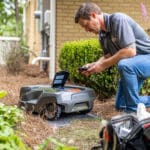
In the early days of the lawn and landscape industry, customer interactions consisted of a firm handshake and paper statements. Nowadays, companies are finding ways technology can augment customer relationships and help them stand out from the crowd.
Different Tech Solutions
Depending on the nature of your business will determine what type of technology is the most beneficial for your organization when it comes to communicating with clients.
For instance, R&R Landscaping, based in Auburn, Alabama, utilizes the Groundwork program for video project submissions. Leads can take a video of the space they’re seeking design/build services for.
“It doesn’t replace the initial consultation, but it does help our designers to be better prepared for the consultation, and it gives us some insight into the client,” says Claire Goldman, principal and head of design and business development for R&R Landscaping. “As simple as it is, it opened our eyes to the simplicity and clarity of video.”
They also have their crews send an end-of-the-day update video that walks through the project and includes what they completed and what they plan to focus on the following day. R&R sends update videos to out-of-town clients to stay in front of their questions.
Goldman says they added Groundworks in 2020 due in part to COVID and the fact many of their clients’ properties are vacation homes.
Local Roots Landscaping, based in Pittsburgh, Pennsylvania, created a custom app to communicate with their design/build customers. Kenneth Deemer, co-founder of Local Roots Landscaping, says previously, they were struggling with siloed information and client requests not reaching the necessary parties.
With their Local Roots app, this serves as the primary communication channel for clients and passes the baton to team members during the design/build process. Deemer says anyone can get looped back into the conversation as needed, but there’s one stream of consciousness that everybody has access to.
“The point of contact is the app rather than a person,” Deemer says.

When clients sign their contract with Local Roots, they agree that all communication will run through the app. It has e-sign capabilities for any change orders the client makes and they can also mark up photos when messaging the company.
“As they sign up on the app, they immediately get assigned a project manager, they immediately get these checklists they have to go through,” Deemer says. “Stuff like, I verify my yard will be clear, that cars will be out of the driveway, I recognize this will happen. Just giving them an overall here’s what you should expect for your project, and they sign off on it.”
On the maintenance side of things, Yardnique, based in Morrisville, North Carolina, created their own proprietary software, Syncscape, and has been rolling it out over the past year to provide a more robust user experience. Every time a crew services a property, they generate an Orange Report that covers the work they did that day and the property’s irrigation system health. Customers can share their copy of the Orange Report with interested parties, such as HOA board members.
“As customers provide us with direction for technology, as we roll this out, there are going to be enhancements, and since we own the product, it’s easy for us to make enhancements, but primarily, it’s just tracing growing-season activities, as well as irrigation inspections and repair,” says Eric Hayes, a business developer with Yardnique.
Through Syncscape, Yardnique can send out proactive quarterly plans for the property and regularly gauge customer sentiment.
“If at any time our customer sentiment drops below four stars, it prompts them to tell us why,” Hayes says. “Then they submit it, and we get an instant notification.”
Customers can also send direct messages through Syncscape, which notifies the branch manager and the account manager so they can react instantaneously.
“Our opinion is that it improves the quality of the service and expectations that the property manager has with us as well as just communication,” Hayes says. “They don’t have to chase us down. They have the ability to log an issue or log a message, and multiple people within our company are notified instantly via text.”
Benefits of Technology
All three types of technology feature improved communication, which is essential to positive customer relations.
“We are able to show them exactly what they need to see when we are dictating the video,” Goldman says. “For the most part, it builds trust with the client. When they realize we are answering their questions before they ask, they know they are in good hands and appreciate the level of detail.”
Hayes says a common complaint is how many landscape companies don’t communicate well or in a timely manner, so they wanted a tool that would be consistent across their 30 markets in the Southeast.
“We wanted something different that was instantaneous; that was not one-to-one, it was one-to-many,” Hayes says. “For example, if a tree falls in one of my communities, and it’s serious, that service request will go to a number of people within our organization. It’s not just to one set of eyes. It’s multiple sets of eyes that get that and we can respond quickly.”
Proactive communication via technology also cuts down on the number of customer complaints.
Deemer says the Local Roots app allows for greater accountability, and they’ve had far fewer surprises with upset customers. He notes that when people don’t know where to place their ire and frustrations, it can multiply by two or three. People now have a clear channel to voice any problems, preventing them from being even more upset.
“Ultimately, the better you communicate, the better the quality of the landscape is going to be,” Hayes says.
Deemer says the app has also helped them appear very professional. Their subcontractors also communicate within the app.
“We will bring in subcontractors to run full-scope projects that we don’t have the bandwidth to run,” Deemer says. “From the client’s perspective, that’s just one giant Local Roots experience. It doesn’t feel segmented like it could if they weren’t in there.”
Challenges of Technology
One of the main challenges to implementing technology within your company is internal and external resistance.
Internally, you can have issues with team members not adopting the technology, making it harder to create the difference you want to see. Goldman says internal buy-in is necessary to ensure the experience is consistent regardless of who you talk to in the company.
“Everyone is always resistant to change,” Hayes says. “It takes a lot of hand-holding and internal selling, and we have to have executive leadership championing this technology and making certain that everyone knows how important it is and what it means to the client.”
On the client side, they can be reluctant to use it because they dislike change or technology specifically.
What’s important is not to force your customers who are tech-resistant to use the platforms you have.

“We work to meet the client where they are and our goal is that they feel like they are our only client,” Goldman says.
Another challenge is balancing your technology usage while retaining the human touch at the core of your business relationships.
Goldman says video communication on the job site, Zoom design presentations, and virtual project submittals, expedite the connection between the company and the client.
“We’ve learned that we can’t get so caught up in emailing and texting that we forget to just pick up the phone and have a conversation,” Goldman says. “At R&R Landscaping, our relationships with each other and our clients are at the forefront of our focus.”
Hayes says their account managers are still required to make face-to-face contact with every customer every week, so Syncscape is not negatively impacting their relationships with clients.
“Since we’re rolling this out, it’s even more important that we’re in front of them to make certain that they know how the technology works and how to utilize it,” Hayes says. “I think, at this point, it’s requiring us to spend more time face-to-face with our clients.”
Deemer says it’s rare for them to have a whole conversation within their app. It’s more of a way to preserve information discussed and make sure everyone is on the same page.
“We’re basically just trying to close all the doors behind us as we go,” Deemer says. “You said it, you acknowledged it, you’re saying you’re happy with this. If you get there and you don’t like it, that is now a change order rather than a ‘You didn’t listen to me.’”
Advice for Others
When it comes to adding technology to your customer interactions, Deemer notes there are lot exciting options available so it’s important not to fall for shiny object syndrome. Consider if the technology in question is something that actually solves your problems or improves something in your organization.
“Identify your problems first and let that drive your search and your engagement with the technology rather than just being like, ‘We’re engaging with technology because we like it and think it’s cool,’” Deemer says. “When I say problems, it doesn’t have to be this open sore in the company, like the terrible thing that’s happening. It could be, ‘Hey, this could be better, this could be improved.’”
Hayes encourages landscapers to think through what they want to accomplish and do their due diligence.
“I would not select something just because they claim to be the industry leader,” Hayes says. “There’s some great technologies out there, in my opinion, that could be rolled out to enhance the customer experience.”
Deemer adds that whatever technology you add should be simple, integrated and streamlined. It has to impact the customer experience positively. He stresses that whatever technology you implement should not inhibit the personal interaction and trust a person should feel towards your company.
“Keep it simple and commit,” Goldman says. “Don’t try to implement everything at one time. At the end of the day, your technology is only as good as your systems. Focus on consistency and building trust with your customers.”
This article was published in the July/August issue of the magazine. To read more stories from The Edge magazine, click here to subscribe to the digital edition.




